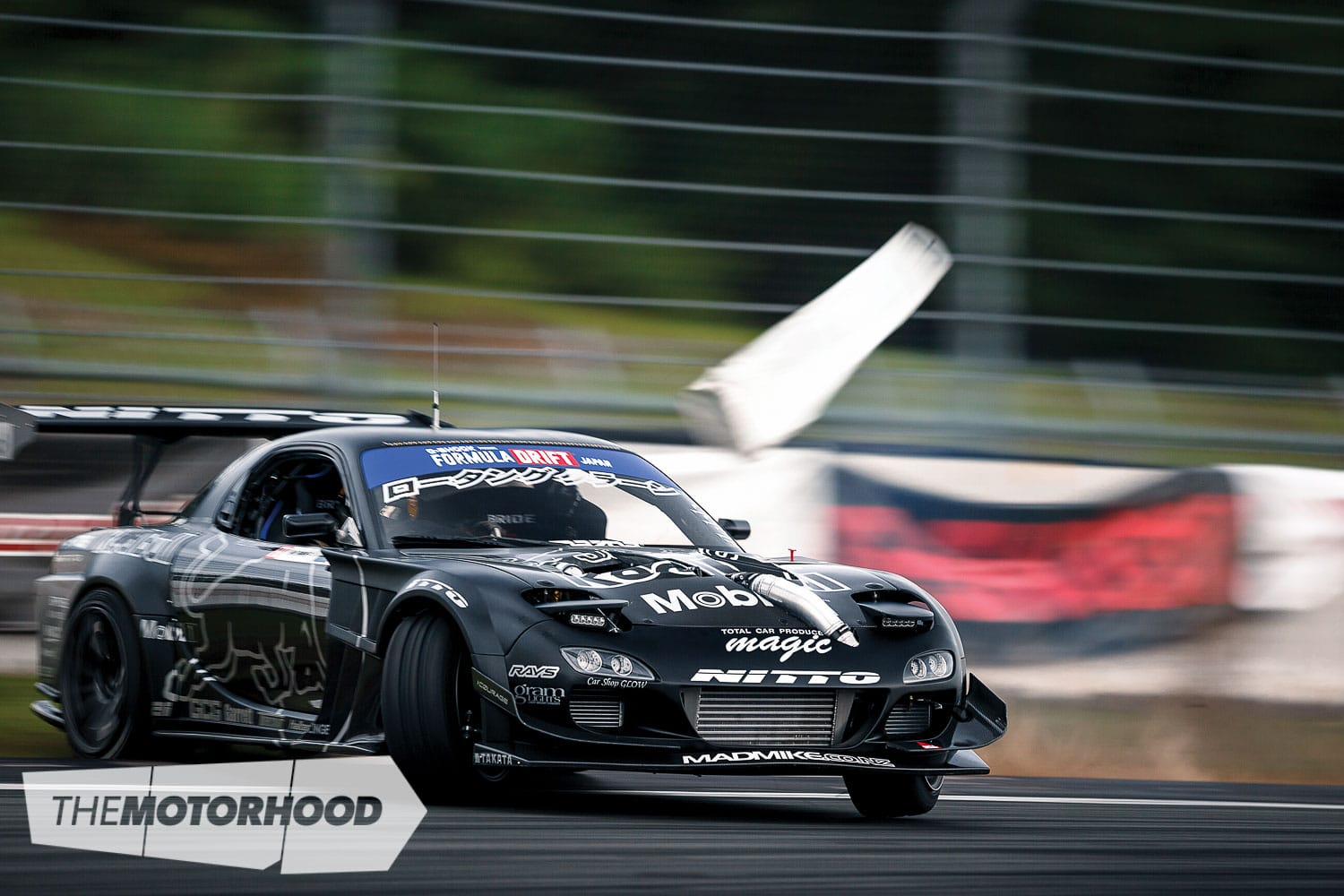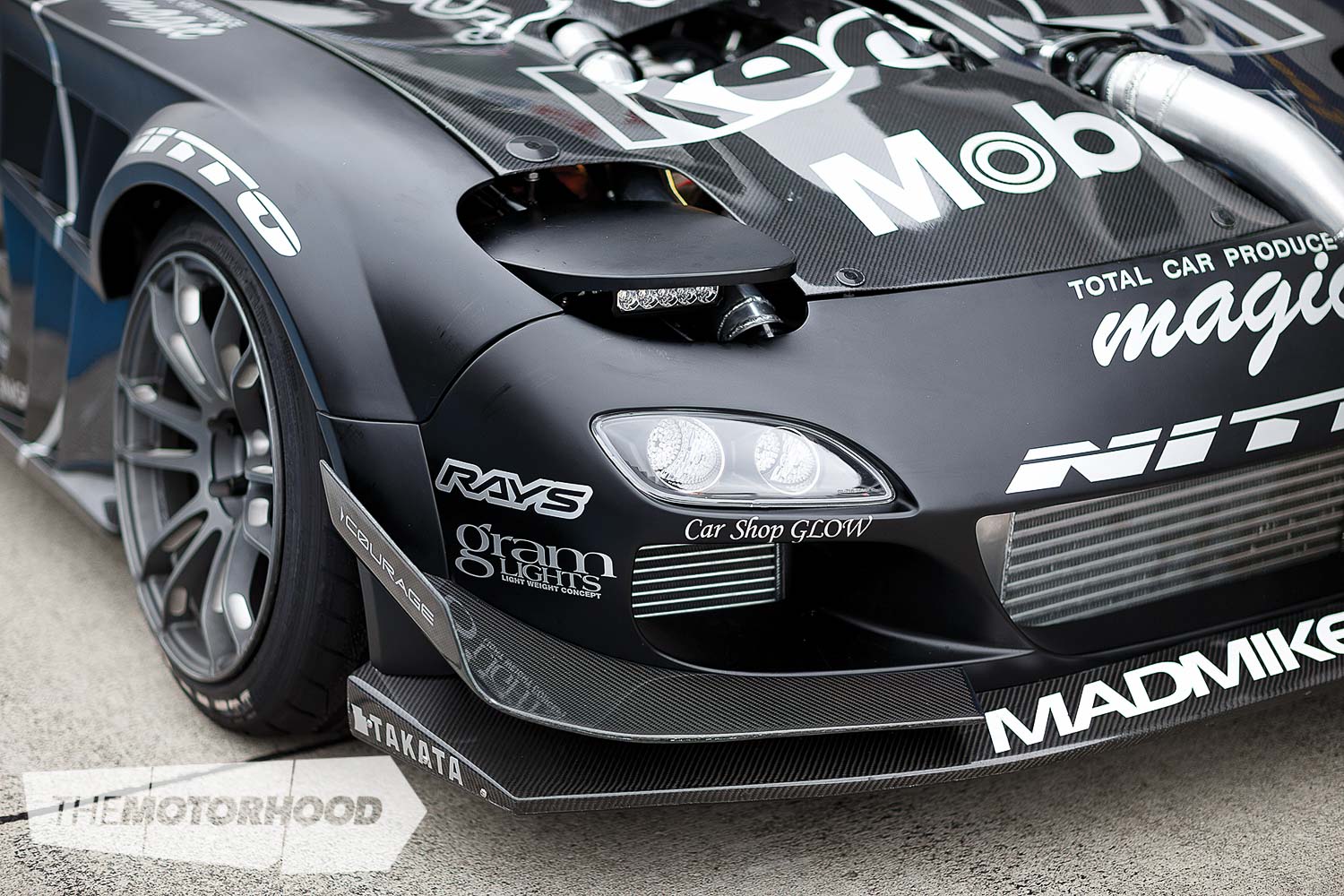“Amid a sea of 2JZs there is one Japanese workshop that’s staying true to its roots, and it has teamed up with a Kiwi to spearhead the counterattack”
If we ask you for the first name that springs to mind when we mention the words ‘rotary engine’, I would take a wild guess that it’ll be Mad Mike Whiddett, a man who has forged a career out of drifting rotary-powered cars all over the planet. But with the influx of 745kW-plus 3.4-litre 2JZs and big-capacity V8s in Formula Drift, for Mike to stay competitive he has had to do some radical thinking to extract maximum torque from the rotary.

You will likely have seen the solution put into action in his RADBUL MX-5 with the 895kW twin-turbo 26B, but his goal is to contest the Formula Drift World Championship in 2016, and having only one car makes that an impossible task given rounds in both the USA and Asia. Enter Kawato-san of Total Car Produce Magic in Nishinomiya City, Japan. “I met Kawato in 2009, the first time we took MADBUL to compete at D1GP in Okayama, he offered us his shop to work out of. Then a year after we did the ICEBUL project together, and then JAPBUL. Kawato is very driven, and wants to win, so he is doing everything he can with the build of HUMBUL,” Mike explained to NZ Performance Car.

As Mike explains it, drifting in Japan is judged differently, as they take into account the way the car ‘dances’ (squats and rolls). This vehicle has a serious amount of grip thanks to the Kawato-spec DG5 coilovers
Kawato’s shop is highly respected for its work with the FD RX-7, but in his 15 years of building rotarys, JAPBUL’s 26B was the first naturally aspirated engine and quad-rotor engine he built. No one really builds four-rotors in Japan, so it was a great challenge for Kawato, with a lot of trial and error to get it perfect. It became something of a training run before he built one for boost, as even back then Kawato knew it would need a turbo to be competitive against the 745kW invasion.

When Formula Drift announced its Japan events, and later the world championship, the team shifted focus from D1GP to running the FD Japan, which meant building a car that suited those rules.

Cutting up JAPBUL to start again from scratch made no sense, besides, Kawato had developed a soft spot for the engine. “I love the sound of the NA four-rotor, we will just keep it and use it for a few demos with Mike driving,” he told NZPC. So that meant they needed a new chassis, and it just so happened that project ICEBUL was sitting dormant in the back of Kawato’s shop.
The work began with the RX-7 being stripped bare, and both the front and rear structures being chopped off and replaced with tube. Like everything with this build, all the chassis work was carried out in-house at TCP. “I have never met anyone that does so much by themselves, and to this level. This is where the name HUMBUL came from. Kawato is the most humble person I know, the complete opposite to the car he has built,” Mike explained.

The engine was actually pieced together long before the chassis work began. It consists of 13B housings and plates, which Kawato bridge ported, plus Series 6 9.0:1-compression rotors, Kawato’s own three-piece apex seals and a three-piece eccentric shaft made here in New Zealand. One of the most challenging factors when building a side-ported four-rotor is getting the four primary and four secondary ports all the same size, a time-consuming job, Kawato admits. As for the MX-5, Kawato opted for twin turbos over a large single, only this time choosing slightly smaller Garrett GTX3582Rs turbos over RADBUL’s GTX4088R, sacrificing a little top-end power in favour of boost response down low.

Where possible Mike has brought his partners from his other cars over to this build. That includes companies like Haltech, which supplied the Elite 2500 ECU and Racepak data-logger dash
The rest of the driveline mirrors that of the MX-5, with a Holinger RD6 six-speed sequential, ASD Winters quick-change, and carbon Driveshaft Shop driveshaft and axles. The MX-5 found the limits of the Winters diff, so whatever they decide to do with that, will likely also be brought over to HUMBUL.

A large custom plenum with a short four-inch charge pipe dominates the engine bay, leaving little room for engine auxiliaries. As with most pro-spec drifters these now reside in the boot space, which also carries the electric power steer bits, and the cooling system. Kawato tells us the latter is a work in progress, and he is still working out how to get more clean (cold) air to the cooler, as currently a single vent in the rear hatch provides air flow.

The fuel system is insane, with no fewer than five Bosch pumps and a mass of braided lines sitting where the rear seat would have once resided. This is set to change, with a full Aftermarket Industries set-up soon to go in
The fuel system is another area that is getting a rework, with Aftermarket Industries supplying a matching system to that found in RADBUL to simplify things over the current army of Bosch 044s doing their best to feed the hungry four-rotor.

It was the few airflow and fuel-feed teething issues that plagued the team during the shakedown at the Formula Drift Japan round. But what little seat time Mike did get was enough to tell him this will be a weapon once those small problems have been sorted.
A weapon is something Mike has grown to expect from Kawato, who has always impressed with how he gets the FD chassis to work. In D1GP the judges look at how the car dances around (squats and rolls). All you need to do is compare a video of how MADBUL and JAPBUL move during drift to see the difference in the cars’ body language. “MADBUL has always been really stiff, and we relied on the rear wing to get the grip, but with JAPBUL and now HUMBUL it’s the suspension that is giving us the massive amount of grip. It always blew me away how JAPBUL handled, it might have been the least powerful in the stable, but it was always dialled. I learned a lot about suspension with that car, about shock, stroke etc.” The suspension set-up is achieved through a special set of DG5 coilovers built to Kawato’s specs. So it should come as no surprise that HUMBUL is a carbon copy of JAPBUL underneath, with the same adjustable arms, lock mods, geometry and coilovers. The only change been a slightly stiffer rate spring to compensate for the added weight of the boost system.

Kawato produces his own aero, known as G-Face. “I don’t use computer software, when designing it I am thinking about a cool look, but also about downforce,” Kawato explains. This is the second generation of the kit, the first being on JAPBUL. Dare we say, this is one of the best-looking FD kits on the market?
What this means is, unlike RADBUL — which saw Mike challenged to tame a completely new animal — the FD is a very familiar place for Mike to be. It’s the chassis he has done the most drift kays in, and having spent the last four years drifting JAPBUL, it shouldn’t take long for him to come to grips with effectively the same chassis, only double the power.
In 2016 the Formula D world Championship will see Mike make his first attempt at the world crown. With the USA- and Japan-based crews working to perfect both cars, and Mike getting in as much seat time as humanly possible before the first round, it will be an exciting year for Kiwi drift fans as we’re glued to the live streams to cheer on Mike and his quest.

1996 Mazda RX-7 (FD3S)
Heart
- Engine: Custom-built 26B four-rotor
- Block: Bridge-ported plates, 13B housings, custom two-piece eccentric shaft, TCP-Magic three-piece apex seals,
- Intake: Plazmaman 100mm throttle body, custom manifold
- Exhaust: Twin
- Turbo: Twin GCG Garrett GTX3582R
- Wastegate: Four Turbosmart Comp-Gate 40
- BOV: Turbosmart Race Port 50mm
- Fuel: Injector Dynamics ID1000 primary injectors, Injector Dynamics ID2000 secondary injectors, Turbosmart FPR-2000, Martini Racing E85, Fuel Safe fuel cell
- Ignition: Haltech CDI
- ECU: Haltech Elite 2500
- Cooling: Rear-mounted alloy radiator, EWP
Drive
- Gearbox: Holinger RD6-SS, six-speed
- Clutch: Exedy carbon triple-plate
- Flywheel: Exedy
- Diff: ASD-prepared Winters Quick Change (full spool)
- Extra: Driveshaft Shop carbon propshaft
Support
- Struts: DG5 TCP-Magic special version
- Brakes: Project U calipers, two-piece Project U rotors
Shoes
- Wheels: (F) 18×9.5-inch (+12) Rays Gram Lights 57Xtreme (R) 18×10.5-inch (+12) Rays Gram Lights 57Xtreme
- Tyres: (F) 235/40R18 Nitto NT05 (R) 275/35R18 Nitto NT05
Exterior
- Enhancements: TCP Magic G-Face full aero, Rocket Bunny GT wing, carbon-fibre bonnet, carbon-fibre hatch, carbon-fibre doors, Car Shop Glow LED lights, Takata tow hook
Interior
- Seats: (F) Bride Low Max, Takata Harness
- Steering wheel: Key’s Racing
- Instrumentation: Haltech IQ3, custom meter panel
Power :745kW (1000hp) at the wheels
Driver profile
- Driver: Mad Mike Whiddett
- Location: Auckland, NZ
- Occupation: Drift driver
- Build time: 12 months
Photos: Larry Chen
View fullsize

View fullsize

View fullsize

View fullsize

View fullsize

View fullsize

View fullsize

View fullsize

View fullsize

View fullsize

View fullsize

View fullsize

View fullsize

View fullsize

View fullsize

View fullsize

View fullsize

View fullsize

This article was originally published in NZ Performance Car Issue No. 227. You can pick up a print copy or a digital copy of the magazine below:





